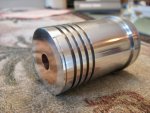From the three laws of thermodynamics, heat can be moved from one body to another without doing macroscopic work by conduction, convection and radiation. Heat will move from one body to the other when they are in thermal contact until an equilibrium is reached. Primarily what we are interested in is radiant heat. The rate at which a body emits radiant energy is proportional to the fourth power of its absolute temperature, also known as Stefan's Law. P=sAeT^4, where P=power radiated by a body in W= watts, s=a universal constant, 5.6696 X 10^-8 W/m^2, A=surface area of the body in m^2, e is a constant called emissivity and T= absolute temperature in degrees K. As can be seen by this equation, the radiant energy is independent of the material it is made of. So, it would seem that heat is moved into the air from a body simply by its surface area and not because of its ability to conduct heat into or out of it. If you have something more to add to this or to counter it, please show me.









